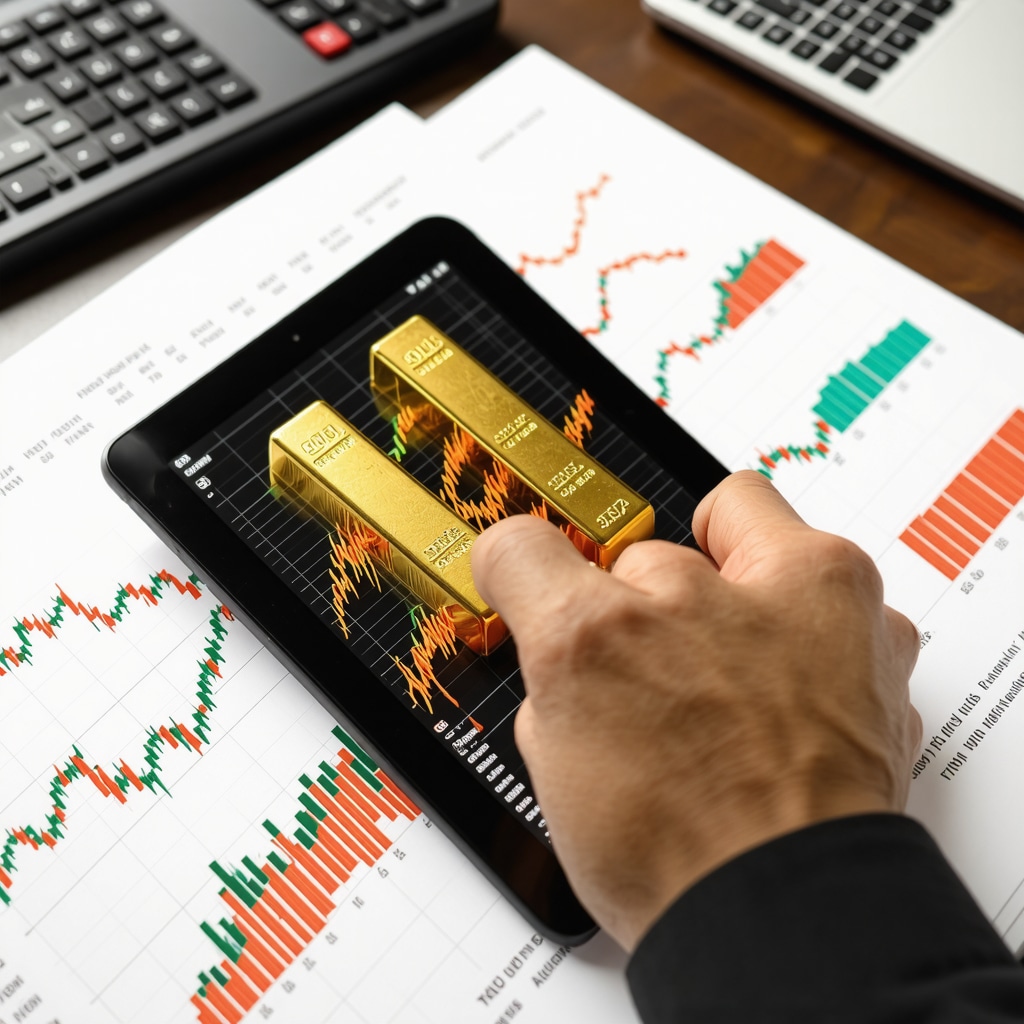Unlocking the Golden Opportunity: Why Analyze Gold Stocks?
Gold stocks represent a unique intersection between precious metal investment and equity markets, offering new investors a compelling way to diversify portfolios. Unlike physical gold, gold stocks provide exposure to mining companies whose fortunes are tied not only to gold prices but also operational efficiencies, geopolitical dynamics, and market sentiment. Understanding these nuances is essential for making informed investment decisions that go beyond simply tracking bullion prices.
Mining the Data: Key Metrics That Reveal Gold Stock Potential
When evaluating gold stocks, it’s imperative to look beyond the surface price of gold. Investors should scrutinize financial health indicators like cash costs per ounce, all-in sustaining costs (AISC), and debt levels. For example, a mining company with consistently low AISC and manageable debt is better positioned to weather gold price volatility—an insight drawn from observing companies such as Barrick Gold and Newmont Corporation. Operational metrics like production growth and reserve replacement ratios also provide critical signals about long-term viability.
How Do Market Forces Shape Gold Stock Performance?
Gold stocks are influenced by a mosaic of market forces including global economic trends, currency fluctuations, and central bank policies. For instance, rising inflation often elevates gold prices, boosting mining company revenues. Conversely, a strong U.S. dollar can pressure gold prices downward, impacting stock valuations. The geopolitical climate, such as trade tensions or regional conflicts, also plays a pivotal role in investor sentiment. Recognizing these dynamics enables investors to anticipate potential market shifts and align their gold stock investments accordingly.
The Role of Economic Cycles and Gold Stocks: Timing Your Entry
Economic expansions and contractions distinctly affect gold stocks. During recessions or periods of financial uncertainty, gold often acts as a safe haven, causing mining stocks to rally. Conversely, in bullish equity markets, riskier assets may outshine gold miners. Seasoned investors harness this cyclicality by analyzing macroeconomic indicators like interest rate trends and inflation expectations to time their gold stock purchases strategically, enhancing portfolio resilience.
Assessing Management Quality: The Hidden Asset in Gold Stocks
Behind every successful mining stock lies a management team adept at navigating operational challenges and capital allocation. Investors should evaluate leadership track records, corporate governance standards, and commitment to sustainable mining practices. Transparent communication and responsiveness to environmental and social governance (ESG) concerns increasingly influence stock performance and investor trust in this sector.
For those eager to deepen their understanding of gold investments and diversify with strategic assets, exploring various types of gold investments offers invaluable perspective.
Practical Steps for New Investors to Analyze Gold Stocks with Confidence
Begin by researching industry reports from authoritative sources like the World Gold Council, which provides comprehensive data on gold supply, demand, and mining company performance. Utilize financial tools to assess price-to-earnings ratios, dividend yields, and cash flow stability of gold stocks. Furthermore, paper trading or simulated investment platforms can offer hands-on experience without risk. Combining quantitative analysis with qualitative insights about geopolitical and economic contexts builds a robust foundation for investment decisions.
For a beginner-friendly approach to safely entering the gold stock market, consider reading this guide on buying gold stocks with low risk.
Ready to explore the shining potential of gold stocks? Share your thoughts below or join the conversation to learn from fellow investors and experts.
Source: World Gold Council – Gold Market Research and Insights
Decoding the Impact of Geopolitical Risks on Gold Stock Valuations
Geopolitical instability remains a paramount factor influencing gold stock valuations. Political unrest, trade sanctions, and resource nationalization risks can dramatically alter mining companies’ operational landscapes, thereby affecting their stock prices. Investors must incorporate geopolitical risk assessments into their analysis, leveraging tools such as country risk ratings and monitoring global hotspots. For instance, mining operations in politically volatile regions like parts of Africa or Latin America may face abrupt disruptions, leading to sharp stock price swings despite favorable gold prices.
Moreover, understanding how governments’ mining regulations and taxation policies evolve can provide early warnings of potential cost escalations or operational limitations. This strategic foresight is essential to avoid value traps and capitalize on opportunities in emerging markets where gold mining prospects remain strong yet politically sensitive.
Integrating ESG Factors: How Sustainability Shapes Gold Investment Outcomes
The integration of Environmental, Social, and Governance (ESG) criteria has become indispensable in evaluating gold mining stocks. Mining companies that proactively adopt sustainable practices—such as reducing carbon footprints, ensuring fair labor conditions, and engaging with local communities—tend to attract long-term investor confidence and command premium valuations.
ESG compliance not only mitigates reputational risks but can also translate into operational efficiencies and regulatory advantages. For example, companies with robust water management systems and minimal environmental liabilities often experience fewer regulatory delays or fines. Investors aiming for resilient portfolio performance should prioritize gold stocks with transparent ESG disclosures and verifiable sustainability commitments.
What Advanced Analytical Techniques Can Enhance Gold Stock Selection?
Experienced investors often employ multifaceted analytical approaches that combine traditional financial metrics with alternative data analytics and predictive modeling. Leveraging machine learning algorithms to analyze historical gold price patterns alongside mining production data can uncover nuanced correlations and timing signals. Sentiment analysis of news and social media may also provide early indicators of market sentiment shifts affecting specific gold stocks.
Furthermore, scenario analysis involving macroeconomic variables—such as inflation rates, interest rate trajectories, and currency fluctuations—enables constructing robust investment theses resilient under various economic conditions. These advanced techniques require access to comprehensive data sources and proficiency in data science tools but can significantly elevate investment decision quality.
For investors seeking foundational to advanced knowledge on gold investment strategies, exploring effective gold investment strategies to hedge against inflation is highly recommended.
Risk Management: Balancing Exposure Through Portfolio Diversification
While gold stocks offer attractive growth potential, their inherent volatility necessitates prudent risk management. A diversified portfolio that balances physical gold holdings with gold equities, ETFs, and even related commodities minimizes unsystematic risks tied to individual companies or regions.
Allocating investments across various segments—such as large-cap miners, exploration companies, and royalty trusts—can further smooth performance volatility. Additionally, understanding correlations between gold stocks and other asset classes aids in optimizing portfolio risk-return profiles. This strategic diversification is foundational to preserving capital during market downturns and capitalizing on gold’s role as a hedge.
Investors can deepen their understanding of portfolio diversification with gold assets by reviewing exploring types of gold investments for diversified portfolios.
Leveraging Expert Resources: Where to Find Authoritative Gold Market Insights
Access to high-quality, authoritative information sources is critical for staying ahead in gold stock analysis. The World Gold Council remains a cornerstone for comprehensive market data, while financial platforms like Bloomberg and Reuters provide timely news and analytics. Additionally, consulting specialized research reports from investment banks and independent commodity analysts can unveil proprietary insights.
Academic journals and industry conferences also offer in-depth discussions on mining technologies and market trends that can impact future valuations. Staying connected with expert communities through forums and webinars fosters continuous learning and networking opportunities.
According to the World Gold Council’s research, the integration of multifactor analysis including ESG considerations and geopolitical risk assessment is becoming standard practice for institutional investors, reflecting evolving market sophistication.
Engage with this post by sharing your thoughts or questions about advanced gold stock analysis techniques. Also, consider reading more on understanding gold demand trends to complement your investment strategy.
Harnessing Quantitative Models to Predict Gold Stock Movements Amid Market Volatility
In the realm of gold stock investing, deploying quantitative models facilitates a deeper understanding of price dynamics and operational risks. Sophisticated investors often utilize multifactor regression analyses that integrate gold price fluctuations, production metrics, and macroeconomic variables to forecast stock performance. These models can parse through vast historical datasets to identify leading indicators of stock rallies or downturns, enabling proactive portfolio adjustments.
One compelling approach involves combining moving average convergence divergence (MACD) indicators with gold mining operational data, such as quarterly production output and cost fluctuations. This hybrid technique enhances timing precision, particularly in volatile markets where gold prices may oscillate sharply due to geopolitical shocks or monetary policy shifts.
How Can Scenario-Based Stress Testing Improve Gold Stock Portfolio Resilience?
Stress testing through scenario analysis is critical for managing exposure in gold stock portfolios. By simulating extreme but plausible economic and geopolitical conditions—such as hyperinflation, abrupt interest rate hikes, or mining disruption due to political unrest—investors can evaluate potential impacts on stock valuations and liquidity. This process reveals vulnerabilities within the portfolio, guiding strategic hedging or reallocation decisions.
For example, a stress test might model the effects of a sudden devaluation of the U.S. dollar combined with increased regulatory restrictions in a key mining jurisdiction. Understanding these compounded risks helps investors preempt losses and identify opportunities in companies with robust operational flexibility or diversified asset bases.
Incorporating Real-Time Alternative Data for Enhanced Gold Stock Insights
Beyond traditional financial statements and market data, alternative data sources such as satellite imagery of mining sites, supply chain analytics, and social media sentiment analysis are transforming gold stock evaluation. Satellite data can reveal operational disruptions, environmental compliance, or expansion activities before official reports, providing a competitive informational edge.
Similarly, analyzing real-time supply chain logistics helps anticipate production bottlenecks or cost escalations, while sentiment analysis quantifies market mood shifts that may affect stock demand. Integrating these datasets with machine learning algorithms enables nuanced predictive modeling that outperforms conventional analysis.
Research from Nature Scientific Reports underscores the growing efficacy of satellite and alternative data in commodity market forecasting, emphasizing its applicability to gold equities.
Tailoring Gold Stock Investment Strategies to Institutional Versus Retail Investor Profiles
Investment tactics diverge markedly between institutional and retail investors in the gold stock arena. Institutions often leverage sophisticated risk models, access exclusive data feeds, and engage in active dialogue with mining management teams, enabling nuanced position sizing and derivative usage for hedging.
Conversely, retail investors may focus on fundamental analysis and diversified gold ETFs to mitigate risks. Understanding these differences is vital for aligning investment strategies with available resources, risk tolerance, and time horizons. Hybrid approaches, such as utilizing robo-advisors with integrated ESG filters, are emerging as accessible tools for retail participants seeking advanced insights without deep technical expertise.
What Are the Key Challenges When Applying AI-Driven Models to Gold Stock Investing?
While AI and machine learning offer powerful forecasting capabilities, challenges persist in their application to gold stocks. Data quality and availability can be inconsistent, especially in regions with limited transparency. Model overfitting to historical patterns may lead to poor adaptability amid unprecedented geopolitical events or technological disruptions.
Moreover, integrating qualitative factors like management changes or regulatory shifts into quantitative frameworks remains complex. Ensuring interpretability and human oversight is essential to prevent reliance on black-box predictions that might overlook critical nuances.
Investors interested in the intersection of AI and commodity investing are encouraged to explore ongoing developments through specialized resources and forums focused on fintech innovations in asset management.
To deepen your expertise in advanced gold stock analysis and innovative investing techniques, consider exploring our comprehensive guide on predictive gold investment strategies. Engage with our community to share insights and enhance your investment acumen.
Harnessing Quantitative Models to Predict Gold Stock Movements Amid Market Volatility
In the realm of gold stock investing, deploying quantitative models facilitates a deeper understanding of price dynamics and operational risks. Sophisticated investors often utilize multifactor regression analyses that integrate gold price fluctuations, production metrics, and macroeconomic variables to forecast stock performance. These models can parse through vast historical datasets to identify leading indicators of stock rallies or downturns, enabling proactive portfolio adjustments.
One compelling approach involves combining moving average convergence divergence (MACD) indicators with gold mining operational data, such as quarterly production output and cost fluctuations. This hybrid technique enhances timing precision, particularly in volatile markets where gold prices may oscillate sharply due to geopolitical shocks or monetary policy shifts.
How Can Scenario-Based Stress Testing Improve Gold Stock Portfolio Resilience?
Stress testing through scenario analysis is critical for managing exposure in gold stock portfolios. By simulating extreme but plausible economic and geopolitical conditions—such as hyperinflation, abrupt interest rate hikes, or mining disruption due to political unrest—investors can evaluate potential impacts on stock valuations and liquidity. This process reveals vulnerabilities within the portfolio, guiding strategic hedging or reallocation decisions.
For example, a stress test might model the effects of a sudden devaluation of the U.S. dollar combined with increased regulatory restrictions in a key mining jurisdiction. Understanding these compounded risks helps investors preempt losses and identify opportunities in companies with robust operational flexibility or diversified asset bases.
Incorporating Real-Time Alternative Data for Enhanced Gold Stock Insights
Beyond traditional financial statements and market data, alternative data sources such as satellite imagery of mining sites, supply chain analytics, and social media sentiment analysis are transforming gold stock evaluation. Satellite data can reveal operational disruptions, environmental compliance, or expansion activities before official reports, providing a competitive informational edge.
Similarly, analyzing real-time supply chain logistics helps anticipate production bottlenecks or cost escalations, while sentiment analysis quantifies market mood shifts that may affect stock demand. Integrating these datasets with machine learning algorithms enables nuanced predictive modeling that outperforms conventional analysis.
Research from Nature Scientific Reports underscores the growing efficacy of satellite and alternative data in commodity market forecasting, emphasizing its applicability to gold equities.
Tailoring Gold Stock Investment Strategies to Institutional Versus Retail Investor Profiles
Investment tactics diverge markedly between institutional and retail investors in the gold stock arena. Institutions often leverage sophisticated risk models, access exclusive data feeds, and engage in active dialogue with mining management teams, enabling nuanced position sizing and derivative usage for hedging.
Conversely, retail investors may focus on fundamental analysis and diversified gold ETFs to mitigate risks. Understanding these differences is vital for aligning investment strategies with available resources, risk tolerance, and time horizons. Hybrid approaches, such as utilizing robo-advisors with integrated ESG filters, are emerging as accessible tools for retail participants seeking advanced insights without deep technical expertise.
What Are the Key Challenges When Applying AI-Driven Models to Gold Stock Investing?
While AI and machine learning offer powerful forecasting capabilities, challenges persist in their application to gold stocks. Data quality and availability can be inconsistent, especially in regions with limited transparency. Model overfitting to historical patterns may lead to poor adaptability amid unprecedented geopolitical events or technological disruptions.
Moreover, integrating qualitative factors like management changes or regulatory shifts into quantitative frameworks remains complex. Ensuring interpretability and human oversight is essential to prevent reliance on black-box predictions that might overlook critical nuances.
Investors interested in the intersection of AI and commodity investing are encouraged to explore ongoing developments through specialized resources and forums focused on fintech innovations in asset management.
To deepen your expertise in advanced gold stock analysis and innovative investing techniques, consider exploring our comprehensive guide on predictive gold investment strategies. Engage with our community to share insights and enhance your investment acumen.
Frequently Asked Questions (FAQ)
What distinguishes gold stocks from physical gold investments?
Gold stocks represent ownership in mining companies whose performance depends not only on gold prices but also on operational efficiency, geopolitical factors, and management quality. Unlike physical gold, which is a tangible asset, gold stocks carry corporate and market risks alongside commodity exposure, offering potential for dividends and capital appreciation.
How do economic cycles impact gold stock performance?
Gold stocks typically rally during economic downturns or periods of uncertainty as gold is viewed as a safe haven. Conversely, in economic expansions, equities may outperform gold miners. Understanding macroeconomic indicators like inflation and interest rates helps investors time entries and exits effectively.
Why is ESG integration critical when analyzing gold mining companies?
Environmental, Social, and Governance (ESG) factors influence operational sustainability, regulatory compliance, and investor sentiment. Companies with strong ESG practices reduce reputational risks, avoid costly delays, and attract premium valuations, making ESG a vital criterion for long-term investment success in gold stocks.
Can quantitative models reliably predict gold stock movements?
While quantitative models incorporating multifactor regression, MACD indicators, and macroeconomic variables enhance forecasting accuracy, they are not infallible. They provide probabilistic insights and timing signals but must be complemented with qualitative judgment, especially given geopolitical and regulatory uncertainties.
How does geopolitical risk affect gold stock valuations?
Political instability, trade sanctions, and resource nationalization can disrupt mining operations and inflate costs, leading to stock price volatility independent of gold prices. Investors should assess country risk ratings and monitor geopolitical developments to mitigate exposure to unstable jurisdictions.
What role does alternative data play in gold stock analysis?
Alternative data such as satellite imagery, supply chain analytics, and social media sentiment provide real-time operational and market insights. Integrating these with machine learning models uncovers hidden trends and early warnings of production changes or sentiment shifts, enhancing investment decision-making.
How should retail investors approach gold stock investing compared to institutions?
Retail investors often rely on fundamental analysis and diversified ETFs to manage risk, while institutions use advanced risk models, exclusive data, and active engagement with management. Retail investors can adopt hybrid strategies, including robo-advisors with ESG filters, to access sophisticated insights with manageable complexity.
What are the key challenges in applying AI-driven models to gold stock investing?
Challenges include inconsistent data quality, model overfitting to historical patterns, and difficulty incorporating qualitative factors like regulatory changes. Maintaining interpretability and human oversight is essential to avoid blind reliance on black-box AI predictions.
How can scenario-based stress testing improve portfolio resilience?
Stress testing simulates extreme economic or geopolitical conditions to reveal vulnerabilities and potential impacts on gold stock portfolios. This foresight enables strategic hedging, reallocation, and identification of companies with operational flexibility, enhancing risk management and preserving capital.
What practical steps can new investors take to analyze gold stocks confidently?
New investors should start with reputable industry reports, analyze key financial metrics like AISC and debt levels, use simulated trading platforms for practice, and stay informed on geopolitical and ESG trends. Combining quantitative data with qualitative context builds a robust foundation for investment decisions.
Trusted External Sources
- World Gold Council (WGC): The authoritative global organization on gold market data, supply-demand analysis, and investment trends, essential for comprehensive gold stock evaluation.
- Bloomberg Terminal: Provides real-time financial data, news, and analytics crucial for tracking gold prices, mining company financials, and market sentiment.
- Nature Scientific Reports: Offers peer-reviewed research on innovative methodologies like satellite data and alternative data analytics applied to commodity markets including gold equities.
- International Council on Mining and Metals (ICMM): A leading body providing ESG guidelines and best practices relevant to sustainable mining operations and governance.
- Investment Bank Research Reports (e.g., Goldman Sachs, JP Morgan): Deliver proprietary insights, in-depth industry analysis, and macroeconomic scenario forecasts that support strategic gold stock investment decisions.
Conclusion
Mastering gold stock analysis requires a multifaceted approach that balances commodity fundamentals, corporate operational metrics, geopolitical awareness, and evolving sustainability standards. From assessing key financial indicators like all-in sustaining costs to incorporating ESG and leveraging advanced quantitative models, investors can navigate the complex gold stock landscape with greater confidence. Integrating alternative data sources and scenario-based stress testing further sharpens foresight amidst market volatility. Whether you are a retail investor starting out or an institution employing AI-driven strategies, understanding these nuanced factors unlocks gold stocks’ full potential as a portfolio diversifier and inflation hedge. Engage with this knowledge by sharing your insights, exploring related gold investment resources, and applying these expert strategies to strengthen your investment acumen in the dynamic gold equity market.










